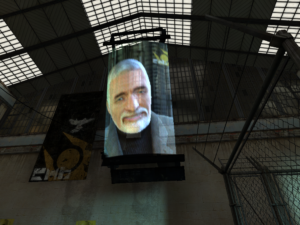Half-Life 2
I’m fortunate enough to be one of the few people who bought the Orange Box without paying for anything twice. I’d played the original Half-Life, and I knew I wanted to try the sequel, but in 2004, when it was released, my home system was behind the technology curve and probably incapable of displaying the game in all its glory. (Even on my current system, the game doesn’t recommend all the highest graphics settings.) So I resolved to wait for it to be anthologized, and was rewarded for that decision with Portal.
 The first and most obvious thing about Half-Life 2 is that it’s graphically impressive — far more so than Portal, which used the same engine. I’m probably more easily impressed by graphics than usual right now, given the quality of the 3D graphics in the last game I played, but that’s not all there is to it. Half-Life 2 puts a lot of effort into strutting its stuff. The first room, for example, has a huge holographic TV: a fuzzily translucent texture-mapped object that uses another realtime 3D scene as its texture. It seems to me like this stuff is somewhat front-loaded, with the biggest visual thrills coming at the very beginning, when you’re just walking along and looking at the scenery because you don’t have a gun yet. As with the first Half-Life, this segment of the game lasts a surprisingly long time, but once you can shoot at monsters, the game seems to settle down into mostly tunnels. But it can’t all be tunnels, can it? There are those immense tripod robots; they wouldn’t fit in tunnels. I’ve caught just the merest glimpse of one of those as it lumbered past a barricaded alley, and that glimpse was breathtaking, even though I had seen pictures of it before. So it’s not just the advanced technology that’s impressive: there’s good cinematography showing it off, which is especially impressive when you consider that the player is in control of the camera. But the player, by and large, looks where the designer wants the player to look. As in an adventure game, it’s all about manipulating the player, and rewarding the player for being manipulated.
The first and most obvious thing about Half-Life 2 is that it’s graphically impressive — far more so than Portal, which used the same engine. I’m probably more easily impressed by graphics than usual right now, given the quality of the 3D graphics in the last game I played, but that’s not all there is to it. Half-Life 2 puts a lot of effort into strutting its stuff. The first room, for example, has a huge holographic TV: a fuzzily translucent texture-mapped object that uses another realtime 3D scene as its texture. It seems to me like this stuff is somewhat front-loaded, with the biggest visual thrills coming at the very beginning, when you’re just walking along and looking at the scenery because you don’t have a gun yet. As with the first Half-Life, this segment of the game lasts a surprisingly long time, but once you can shoot at monsters, the game seems to settle down into mostly tunnels. But it can’t all be tunnels, can it? There are those immense tripod robots; they wouldn’t fit in tunnels. I’ve caught just the merest glimpse of one of those as it lumbered past a barricaded alley, and that glimpse was breathtaking, even though I had seen pictures of it before. So it’s not just the advanced technology that’s impressive: there’s good cinematography showing it off, which is especially impressive when you consider that the player is in control of the camera. But the player, by and large, looks where the designer wants the player to look. As in an adventure game, it’s all about manipulating the player, and rewarding the player for being manipulated.
I’m a couple of chapters in now, and the gameplay has been mostly standard FPS fare with scattered puzzles, but with some twists. There’s a kind of flying robot that flashes a bright light at you, blinding you for a few seconds if you were facing it, which gives the player a motivation to aim away from the enemy sometimes. There’s the exploding barrels, which aren’t new in themselves (they’ve been a mainstay since Doom), but the degree to which the enemies use them as a weapon against you is.
Anyway, I’m quite delighted with the gleefully grim tone of the work. The original Half-Life, with its ironic juxtaposition of alien carnage with things like workplace safety posters, had a strong vibe of comfortable simplicity running headlong into its inadequacy against the horrors of the world, like a 1950’s film on surviving a nuclear attack. (The title itself seems to have been chosen for this connotation. It has nothing to do with the game’s content.) HL2 turns that up a notch, giving us a smiling, genial politico beaming proudly as he welcomes you to his full-blown dystopia and explains why the planet-wide field suppressing human reproduction is actually a good thing.
 Comments(0)
Comments(0)